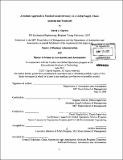A holistic approach to finished goods inventory in a global supply chain : analysis and trade-offs
Author(s)
Segrera, David J. (David Joseph)
DownloadFull printable version (10.06Mb)
Other Contributors
Leaders for Global Operations Program.
Advisor
Stephen Graves and David Simchi-Levi.
Terms of use
Metadata
Show full item recordAbstract
Since Michael Dell returned as CEO in 2007 the company has undergone several changes such as utilizing third party manufacturers, reentry into retail, and a new focus on solution based offerings. Although historically Dell has been a build to order business, it is now expanding into build to plan (such as retail) and build-to-stock (BTS) fulfillment channels. This study focuses on Dell's recent entry into the BTS space and the use of finished goods inventory analysis to understand policy tradeoffs. Finished goods inventory decisions often have implications across multiple groups in a corporation. Decisions such as how many locations in which to hold inventory, where to hold inventory, how to fulfill that inventory, and at what service level cannot be made independently as they often influence each other and can be customer and product dependent. Additionally, external factors such as fuel costs, taxes, and market rates can change frequently, which can alter optimal strategies. A means of quickly evaluating alternative strategies to understand tradeoffs is needed. This study creates a model of inventory associated costs from the point of manufacturing to delivery to the customer for the US computer notebook market and seeks to account for the impacts across multiple organizations. Key inventory levels are explored and inventory theory is utilized. From this study a flexible model has been created that estimates a cost per unit for a given inventory policy as well as a methodology that will be used globally. Key decision makers have also gained greater intuition on the tradeoffs associated with these integrated decisions and have a tool that helps quantify the impacts of changes such as improved forecast accuracy, increased ocean shipment, and higher service levels. In this example, fundamental inventory theory and basic modeling techniques have been utilized to provide a tool that can evaluate complicated tradeoffs and the financial implications of inventory policies. This stresses the importance of knowledge of inventory fundamentals such as risk pooling, type one and type two service levels, and risk management by managers setting policy.
Description
Thesis (M.B.A.)--Massachusetts Institute of Technology, Sloan School of Management; and, (S.M.)--Massachusetts Institute of Technology, Dept. of Aeronautics and Astronautics; in conjunction with the Leaders for Global Operations Program at MIT, 2011. Cataloged from PDF version of thesis. Includes bibliographical references (p. 66-67).
Date issued
2011Department
Leaders for Global Operations Program at MIT; Massachusetts Institute of Technology. Department of Aeronautics and Astronautics; Sloan School of ManagementPublisher
Massachusetts Institute of Technology
Keywords
Sloan School of Management., Aeronautics and Astronautics., Leaders for Global Operations Program.